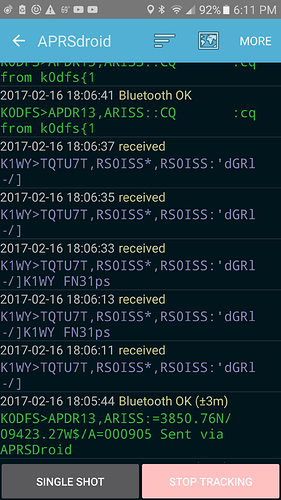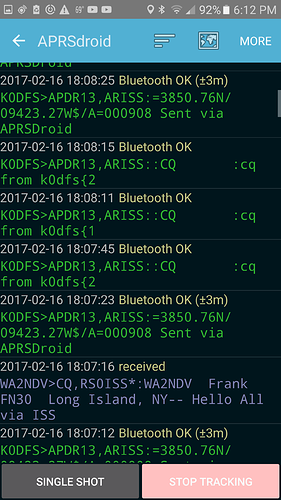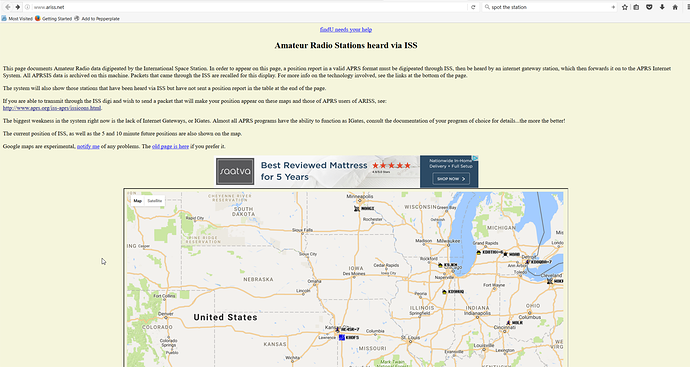Would you believe just a cheap whip. I have a Nagoya NA-771 attached to my Baofeng UV-5R. I use the mobilinkd TNC and APRSDroid. Fun fact about my TNC, I have tried strapping it to the back of the HT a few times and when I transmit it resets and everything dies. I have found just letting it swing free on the wire or sit a few inches away on a table and everything is alright. I think the guy who sells them now sells cables with a choke on them, and I wonder if it is to resolve this issue. I swung that mobile around in the air a little, I probably looked like a nut in my front yard as people drove home from work! I did both receive some packets from the ISS and transmit some that were successfully repeated back, but I also tried a CQ and it never got to the ISS. Oh well, maybe another time. I really need to either build or buy a yagi for satellite work, I would like to try more. This is proof though that you can work space with a cheap handheld and a standard antenna. I know the science makes sense but it is still a bit mind blowing. 
Probably what i said wasn’t very precise - I have to manually press the PTT to transmit the message while also pressing the send button on PocketPacket app on my iPod Touch to transfer the APRS encoded message to the Baofeng.
I have tried using VOX but no luck. Also learned that the simple audio connection from the iPod audio jack to the Baofeng mic jack doesn’t provide the proper signal to activate the PTT. I need to buy or build an interface that does.
But since this is only for experimental purposes to test my iGate and the downloads from Outernet, not sure I’ll take this much further.
The RPi iGate is working fine and I am able to map the stations it hears on my laptop using YAAC.
If I am misunderstanding the VOX and PTT could you set me straight?
Richard
Well done …
I can just see you out there spinning the radio!! LOL!!!
I am jealous of the little TNC , not much like that over here and importing is too expensive 
You might check with them, I see they offer international shipping for $15, not sure if you have to pay import fees on top of that or something? I have had this device for several years and it has proven to be very reliable, pretty much works every time I try it. The battery even seems to hold a charge forever!
Anyway you might contact them and see if there is a reasonable way to get one to you.
I see… 
People “overthink” the cable you need… mine is really easy & out of the junk box 
The problem is that, with the Chinese radios, the PTT is activated by shorting the speaker ground to the mic ground, so ANY common ground will make it transmit…
So… I simply put an audio transformer in the mic cable… So it the cable is “straight through” for the audio OUT of the radio, but both wires from the Mic connector for the radio go to one side of the audio transformer, and the continue from the other side to the device… thus no common earth!
I know purists will hate this, as the impedance will be all over the place, but essentially you just have to have the “volume” of the device up loud enough to just trigger the VOX ( which will be LOUD for various reasons!!)
Audio transformers are usually only a couple of dollars to buy, but if you have an old transistor radio around 
You can probably put the transformer in the speaker lead instead, but I think a phone etc. will be more “forgiving” of the impedance weirdness 
*** IMPORTANT*** anyone who does this, ensure you monitor your transmissions when you do this to ensure you are not making a really BAD noise on the APRS frequency whilst you get it going  Your mileage may vary!
Your mileage may vary!
I better try getting a message to outernet via aprs. I have the exact same gear but after using it once and getting out of range of the aprs digipeater on a car trip I wondered what it was good for. No one would know if I was actually missing or not. Oh well it was half an hour of fun.
that is why I run it on HF ![]()
(well I make sure it WORKS on HF anyway! ) if you look at the beacons that I put out (M0KNC ) that ended up on Outernet today, you will see they went from here (in England) to an igate in Austria using “PSKmail” (http://pskmail.org/ ) , which is on most HF bands (and setting up an Rx igate is easy)
Another thing to try, aprs via VHF AND HF !
What digital mode is most common on HF/VHF?
That is a very open and difficult question to answer Syed, unless someone knows some statistics that I do not. On VHF/UHF AX.25 packet is still around, but mostly used for APRS and some Winlink email service. You may be able to do AX.25 with soundcards (some people even do it holding their phone up to the mic/speaker) but there are a few cheap TNC options out there and a lot of people use them, also APRS is built into some HT’s and mobile rigs too. The other digital stuff going on in VHF/UHF is all of the new digital stuff, I think there are 3 main non-compatible environments out there, Mototrbo/DMR, System Fusion (C4FM-Yaesu) , and D-STAR (ICOM). They allow digital data and voice.
HF with the exception of PACTOR modems for Winlink which are ridiculously expensive almost all modes are done with soundcards (including WINMOR a newer soundcard mode for Winlink). There are lots of modes. PSK-31 and JT9/JT65 seem to be popular. RTTY is still used a lot too. Tons of different modes out there that people are trying though.
Geez what a question @Syed 
Like @dschieszer said that is difficult to answer… I will have go here too.
VHF - All I ever see here (in the UK) is AX25 in it’s “un-protocoled” format that is now called APRS (I was an early pioneer of packet radio in Australia - and it is sad to see the protocols around AX25 have been pretty well lost… We used to do a lot of BBS store & forward, and TCP/ip connections… C’est la Vie… )
You just see a lot of unconnected packets flying around hoping to be heard LOL
6Mtrs is the exception here , you will hear some of the “JT” modes being used for sporadic E “skip” as well as a few more exotic modes including superfast morse for Meteor scatter ( which is fun 
I see NO real “mail exchange” type systems on VHF here - Just Short messages via APRS and internet gateways
Digital voice is (unfortunately IMHO) very popular, but relies 100% on commercial software/firmware and will be a disaster during a … disaster. That is due to its reliance upon “smart” repeaters and the like…
HF: Now on HF you see everything!!! you will see
300baud AX25 doing APRS on 30 Mts (I use that to beacon sometimes)
Pactor and Robust packet modes (expensive modems!) as well as Winmor used to connect t the Winlink HF mail systems ( I use Winmor ) there are a LOT of gateways that store & forward both by radio and the internet on all bands with Winlink
PSKMail (mainly on 30mtrs ) is a small free system that uses only readily available software (FLDIGI is the modem) to allow access via gateways to any email system you want , as well as local document and ONE WAY access to APRS via beacons ( i also beacon to Outernet from this system)
There is a plethora of point-to-point modes for quick QSO’s the most popular are the “JT” modes by a loooooooong shot!
I guess that question needs to be clarified by what you WANT from a digital mode 
I’m mostly interested in what people are doing for modulation, FEC, and framing.
For packet radio that is mostly a very bad situation. Phil Karn KA9Q has made some comments
about that in the past. Due to considerations of compatability with existing equipment, modulations
like 1200 baud AFSK over FM are used, with the bitstream being NRZI encoded HDLC without any FEC,
only CRC-16 checking and go-back-n retransmission. It is what was decided in the early eighties when
some groups started doing data transmission using existing voice radios and available communication
controllers, and it proved very hard to get people upgrading to newer stuff once they “invested” in this
early equipment. There was some adoption of a 9600 baud FSK modem that required modification of
the radio, but it was very limited. Even today, the 1200 baud AFSK sounds can still be heard on VHF.
On HF the same mode was used with 300 baud, but usually over SSB radios so it effectively is FSK.
Improvements for packet radio were suggested but they never materialized.
Instead, new modes that are not intended for data transmissions were invented. They focus on
receiving signals as far below the noise as possible, e.g. for earth-moon-earth communication. But
they convey little more than a pair of callsigns and a report, the minimum required for a QSO.
Seems like the problem could be easily solved these days–and cheaply.
@Syed
There are a few Weird modes out there for HF.
I have spent a LOT of time attempting to push through bad propagation on HF
Here are som of the more “robust” ones , If you feel the inclination you can have a peek at how these work.
WSPR - The most obvious one http://wsprnet.org/drupal/ WSPR is essentially a one way “beaconing” system using incredibly robust FEC and slooooow FSK on a very, very, narrow band.
ROS - This is a very robust ( and weird) MSFK that is technically “Spread spectrum” and, despite the fact that it is all contained within one 2.5Khz “voice” channel is not considered legal in the US ROS - Signal Identification Wiki
FSQCall - I am not even going to try to categorise this one… When there is someone on the other end it uses magic to work… This is not a popular mode yet) but I have had QSO’s with “impossible” stations with it ![]() ZL2AFP FSQ ( I haven’t fiddled with it since the middle of last year & it seems to have been updated a few times since then )
ZL2AFP FSQ ( I haven’t fiddled with it since the middle of last year & it seems to have been updated a few times since then )
I am supposed to be working, so I better go now ![]()
Yes, today you can do everything in DSP. First the DSP-based modems for soundcards appeared,
and now you can do it directly from RF using an SDR like the RTL stick.
However, it remains difficult to change a mode because part of the users will be using old hardware
and users want to communicate independent from the hardware and software they happen to use.
So in practice it more often happens that new modes are introduced that do not replace an existing
mode like AX.25 packet radio, but are a new addition to the field.
The demod used by Outernet is a clear example of how it can be done today even on a comparatively
small computer. But remember when packet radio was first defined, a typical home computer had a
Z80 or 6502 8-bit processor. The first packet controllers used a Z80 as well. They used a HDLC
controller (Z80 SIO or later Z80 SCC) to do the serial processing and a hardware modem. When
the “digicom” program for the Commodore64 first used software serial (bitbanging) with a hardware
modem it was revolutionary. DSP directly from audio would have been quite hard in those days.
Today single-board computers like the Raspberry Pi or CHIP are 100 times faster if not more.
HAHA!! I used to set up Commodore Vic20’s as AX25 digipeaters in remote locations… the computer could be easily converted to run on 12volts, and you could use the old “rs232” chip to make the serial port on them work as a “proper” RS-232 to plug into a TNC. You needed + and - 9Volts
From memory, the C64 was the first “PC” that managed to make the correct tones from the sound output, but that was about all it could do ![]()
The CHIP or a RPi is easily thousands of times more powerful ![]()
My first “digital” machine was a Seimans Teleprinter connected to a current loop circuit from a receiver, and it used to make one HELL of a lot of noise. 45/50 baud baudot It was like this one but mine had no case ![]() siemens T100 teleprinter - YouTube
siemens T100 teleprinter - YouTube
Oh the good old days ![]()
My dad (N0OFW) has 3 or 4 of those teleprinters in his garage. I think I recall him having one hooked up receiving at one point in the 80’s but mostly he just collects random stuff. He had a packet store and forward system set up in our house in the early 90’s when he got his Novice no-code license then as well. He also restores Aladdin lamps and gas powered clothes washers. What can I say, we are odd people! 
The APRS messages to “OUTNET” don’t seem to be getting to the birds (well AlphaSat at least)
ALL the ARPRS messages I see since my forced reboot of the system are from the ISS
I pushed a few test messages via HF the last few days and I can see them on APRS.fi ( so some of them made it to the internet “backbone” but didn’t get seen by whatever magic send it to the OUTERNET systems. )
(friom ARPS.fi)
2017-04-01 15:57:49 BST: M0KNC-4>PSKAPR,TCPIP*,qAS,OE5RTL:!5105.00N/00119.98Wy jpskmail 1.8.7 test Hello to OUTNET from 10Mhz and PSKMail
2017-04-02 15:54:51 BST: M0KNC-4>PSKAPR,TCPIP*,qAS,OE5RTL::Hello :Outernet from HF OUTNET{01
2017-04-03 09:57:45 BST: M0KNC-4>PSKAPR,TCPIP*,qAS,OE5RTL:!5105.00N/00119.98Wy jpskmail 1.8.7 test Hello to OUTNET from 10Mhz and PSKMail



